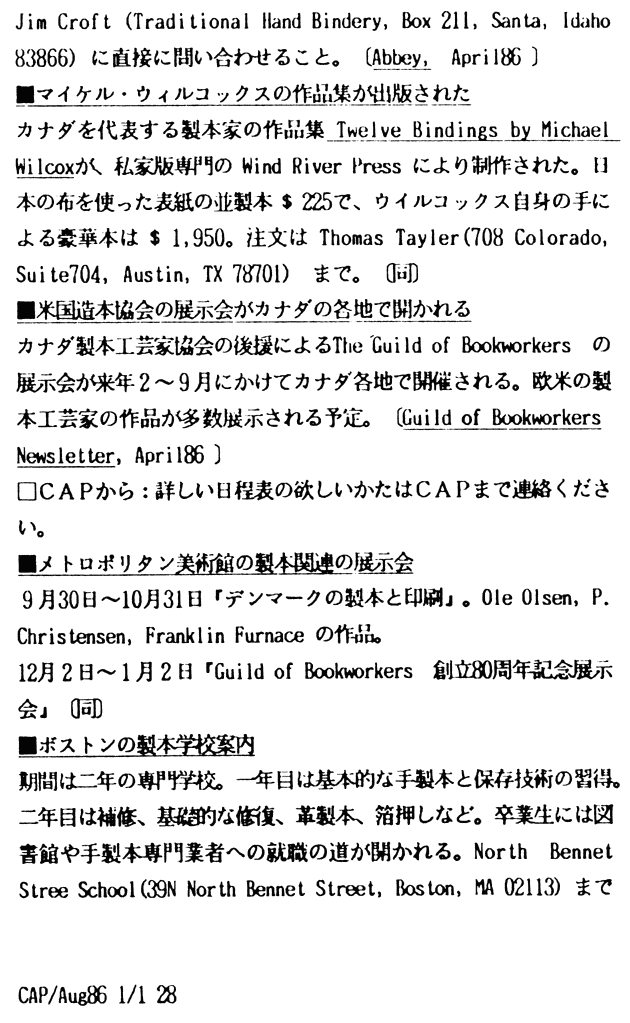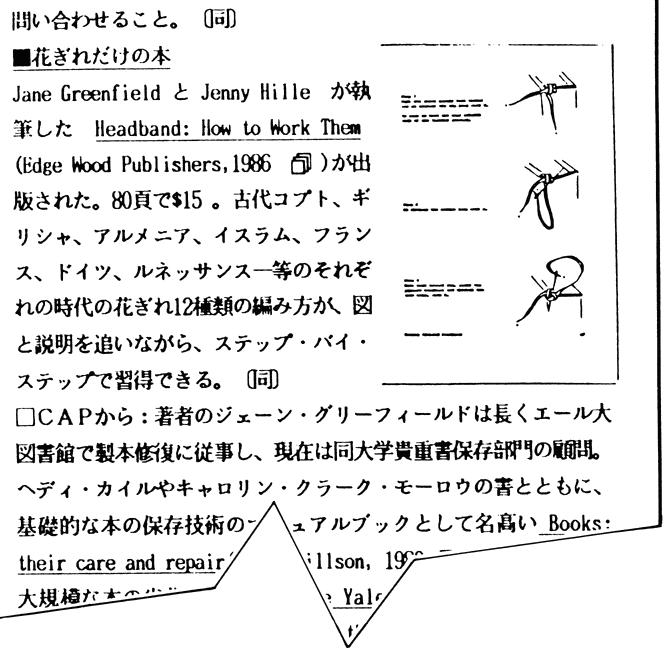

In 1986, two newsletters on bookbinding and preservation were launched in Japan: CAP, Conservation & Preservation (a monthly report on overseas activities in book preservation, about 24 pages, 4½" x 7") and Codex Newsletter:
Bookbinding and Preservation (a quarterly carrying original articles and translations, along with a literature section and a list of coming events in Japan, about 12 pages, 8" x 11½"). Both are in Japanese, printed on alkaline paper. Sample issues of each, with information in English and a long newsy letter were sent by Toru Kibe, the editor and publisher of CAP, in response to a letter of inquiry. He writes:
I launched my personal newsletter CAP after the model of the Abbey Newsletter.
I an only a bookbinder. I have been doing bookbinding for eight years just for pleasure. Four years ago, however, my friend Hirotaka Kanaya--he is a splendid bookbinder in Japanese style--started publishing his personal newsletter, Yuzuri-ha by himself in order to make us aware of the deterioration of papers used in modern books. Since then, as a bookbinder, I have given attention to the conservation/preservation of books....
Here are some numbers which may describe our present situation well. Japan is among the most productive publishing nations in the world. In 1984 the number of titles of nongovernmental publications reached 32,357. Over 32,500 magazines were published. And there were 46,371 libraries in 1985: 38 national libraries, 1,347 academic libraries, 1,601 public libraries, 41,362 school libraries, and 2,148 special libraries.
However, 99% of these libraries have no preservation programs! Almost none have sections and staff for preservation of their own library resources. So many universities and colleges have courses or departments of library and information science, but none has a preservation curriculum. We have no graduate program or department to train conservators in our universities and colleges. We have not yet had a Council on Library Resources, a Verner Clapp, a William Barrow, or a George Martin Cunha. The National Diet Library, the largest library in Japan, had a budget for preservation of its resources, exclusive of microfilming and binding, in 1986. It was only �1,750,000 (not dollars but yen). Only $11,000 to preserve 4,500,000 volumes!
Preservation is in its infancy here. It may be like that situation Pelham Barr wrote about in 1946. He wrote, as you know, "Silence, rarely broken, seems to surround the subject of book conservation" ("Book Conservation and University Library Administration," College and Research Libraries, July 1946).
But I do believe that action is beginning to take shape, slowly but surely. Fortunately, we have now a few librarians and bookbinders who realize the extent of the problem.
And I have collected over 300 pieces of literature related to conservation/preservation of books and bookbinding. I will make a little effort to help those who are surrounded with silence, now through my personal newsletter CAP. In the near future, we will do "From problems perceived to programs in practice."
The Codex Newsletter was launched last April. This has been written and edited by the Group Codex. Seven members are librarians and bookbinders. There are now 250 subscribers....
CAP is my personal newsletter.... I started to publish this newsletter this August. The number of subscribers is about 110 now--not so many but not so few.
As you see, CAP will report on news from overseas. Your Abbey Newsletter is one of my best sources. Unfortunately, I cannot inform you of our news now except for the news enclosed with this letter, but I and the members of the Group Codex are planning to make a pamphlet in English translated by professionals to report the activities of conservation/preservation of Japan. This will be done in March or April next year. I promise to send one to you.
Mr. Kibe enclosed an information sheet in English, titled "On Launching CAP," which says, in part, "Should any reader be interested in seeing the original publications from which our information is obtained [he lists about 401, CAP will be happy to loan them by mail or provide photocopies to the extent allowed by law. Such services will also be offered for books introduced in CAP. CAP has no copyrights except for those [items] for which we have acquired translation rights. Photocopying and further distribution of CAP is in fact in our best interest."
He also sent a sheet with English summaries of the articles in the Codex Newsletter. One is a translation of an article by Bernard Middleton, one is an "introduction" of the eight people who put out the newsletter, and one is an article about W. F. Patterson, by Yuicho Sato. Patterson, it says, 'has been known as the first man who taught us, the Japanese, the techniques of western style bookbinding about 100 years ago." the author, Mr. Sato, "might write A History of Japanese Craft Bookbinding Technique some day."
Mr. Kibe's letterhead, and even the little information sheets, are all on alkaline paper. He also enclosed a paper by Akio Yasue (Preservation Office, National Diet Library, 1-10-1 Nagata-Cho, Chiyoda-ku, Tokyo, 100 Japan) entitled "Preservation/Conservation in Japan." This paper was given at the IFLA conference in Tokyo in September 1986. It says, in part, "Before the year 1982, book paper made and used in Japan, with very few exceptions, was acid paper. But paper makers had been studied [i.e., studying] and developed alkaline paper in the 1970s and in the early 1980s from the viewpoints of paper brightness and cost effectiveness;. ..new widespread concern for book longevity gave impetus to this effort and development. Demands from publishers and librarians, together with the growing public interest, have been transforming book paper from acid to alkaline paper. At present, it is roughly estimated that some 40-50 percent of book paper produced and used in Japan is alkaline. This trend will go forward."

